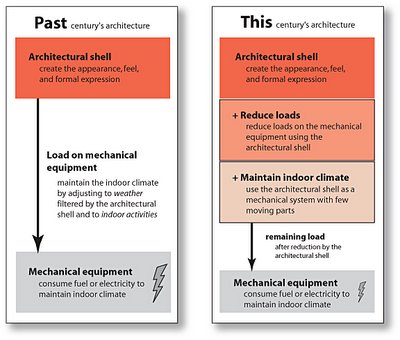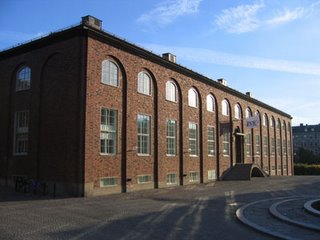"We have all been enjoying the greatest party the world has ever seen: the great oil party," according to Kjell Aleklett, president of the Association for the Study of Peak Oil (ASPO) and a physics professor at Uppsala University in Sweden.
"After the climax comes the decline, when we have to sober up and face the fact that the party is coming to an end," he wrote in a paper earlier this year.
A great site for getting up to speed on the world energy situation:
http://www.dkosopedia.com/index.php/Peak_OilOnce a designer is up to speed on the situation, a designer starts to think about solving problems. A good building should last at least 100 years, barring accidents. The grandchildren of today's architecture students will be living in these buildings: 2105 is not that far away. In the next 100 years, oil production will have fallen off dramatically.
What fuel will we use for transportation, and for powering our buildings? It's more than obvious that we must immediately begin a transformation of our energy infrastructure so we have
something, let alone something
nice, for our grandchildren living in our buildings in 2105.
You won't hear anything about this in the US media, especially not from the US government. For government to acknowledge the energy reality they would have to suggest that people must change their lifestyles. We will not be able to drive cars as much in the future, we'll need public transit, and we'll need denser urban development and architecture to make this possible.
Fortunately the Europeans are not afraid of the future. In Sweden they see the challenge of infrastructure transformation over the next 100 years as an exciting opportunity. I share this view, and my goal is to convince architects to get excited, to educate themselves for the new skills they'll need, and to take more responsibility in the lifecycles of buildings. Architects must make themselves relevant to building production if they want any voice in how the American landscape will be transformed this century.
Architects should take up this responsibility because traditionally we were humanists who used technical knowledge to create beautiful places that made people feel good.
Be sure that the responsibility for transforming our cities and infrastructure will be taken up by someone. Shall it be technical professionals who arrive at technical solutions, without regard for beauty and human well-being? Instead, I believe the responsibility should be taken up by architects who have returned to their roots.
Getting back to what matters in the professionMarcus Vitruvius Pollio, a Roman who lived in the first millenium, in his
Ten Books of Architecture defined the architect's profession as the integration of
firmitas,
utilitas, and
venustas. This is usually translated as firmness, commodity, and delight.
It has only been a short time, during the last century, that mainstream architectural culture trivialized firmness and commodity as fundamental to architectural quality. In a defensive response to the erosion of professional territory to engineering and construction specialists, Architecture became primarily about formal expression with regard to Concept--anything other than pure concept was art compromised, giving still more ground away to other disciplines. This nonsense of professional rivalry has no place in the architecture of this century. Architectural quality in this century must once again be evaluated as an integration of human comfort, environmental performance, and formal expression. Architects today are not trained for this; they are trained to be fashion designers, who are irrelevant for producing 90% of the new buildings made each year.
We architects must learn engineering again. We can start by doing some simple math. Buildings consume about 40% of our energy production in the US. Transportation consumes another 20-30%. We'll have replaced nearly half of American buildings, and renovated a larger fraction, by 2050 when today's graduates from architecture school are retiring. Thus, the arts of architects and urban designers/planners can affect 30-35% of America's energy use by our grandchildren's time, even more considering renovations.
Next steps:
How do energy realities translate into specific performance goals for architecture? See the next postings.
What does energy conservation in buildings have to do with the architect's goal of making beautiful places that make people feel good? See the next postings.

